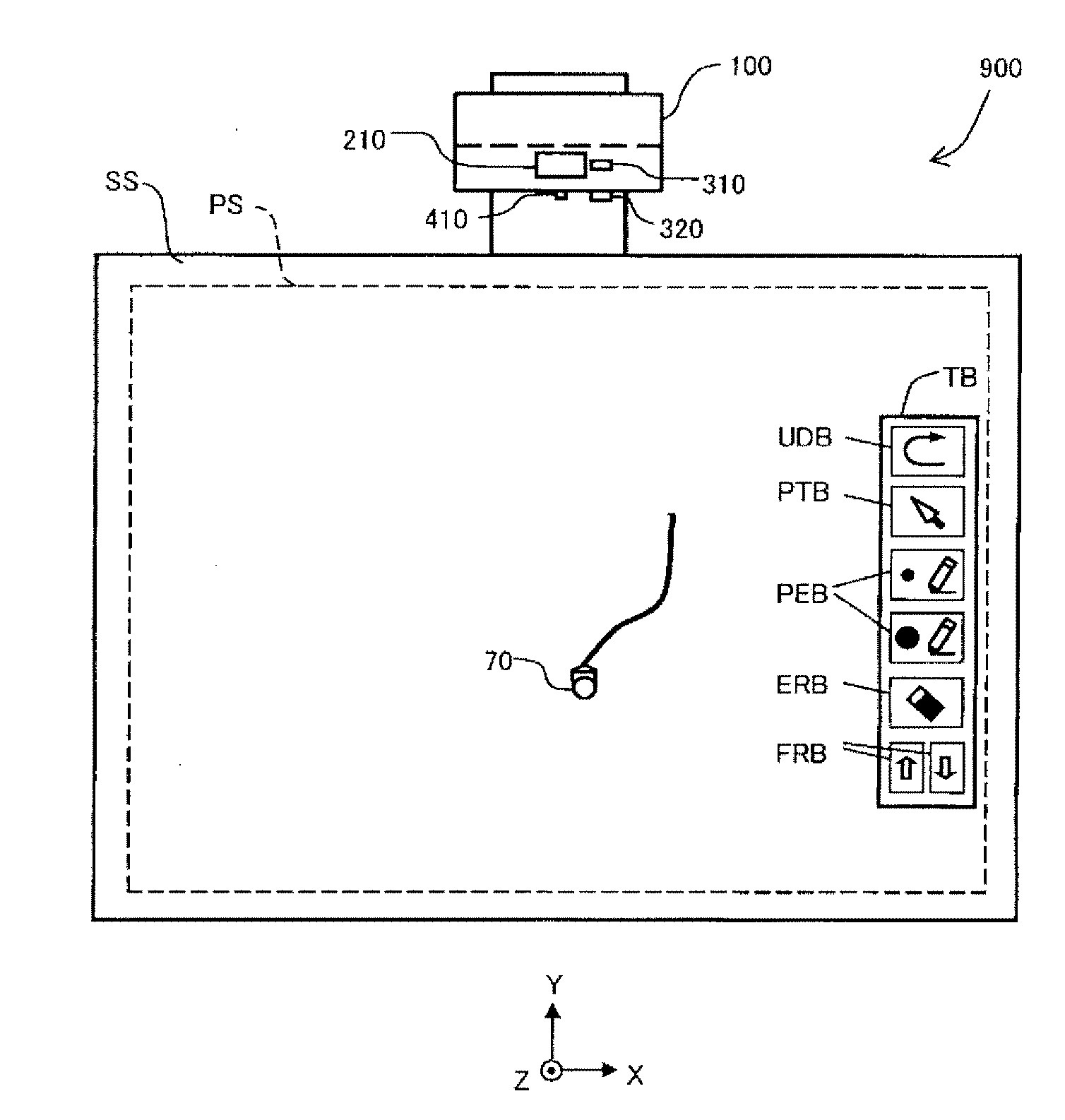Interactive projector and method of correcting z-coordinate of the same
a projector and projector technology, applied in the field of interactive projectors, can solve the problem that the accuracy of contact detection is not necessarily sufficien
- Summary
- Abstract
- Description
- Claims
- Application Information
AI Technical Summary
Benefits of technology
Problems solved by technology
Method used
Image
Examples
first embodiment
A. First Embodiment
[0031]FIG. 1 is a perspective view of an interactive projection system 900 according to a first embodiment of the invention. The system 900 has an interactive projector 100, a screen plate 920, and a light-emitting pointing element 70. A front surface of the screen plate 920 is used as a projection screen surface SS. The projector 100 is fixed in front of and above the screen plate 920 with a support member 910. It should be noted that although the projection screen surface SS is vertically arranged in FIG. 1, it is also possible to use the system 900 with the projection screen surface SS arranged horizontally.
[0032]The projector 100 projects a projected screen PS on the projection screen surface SS. The projected screen PS normally includes an image drawn inside the projector 100. In the case in which the image drawn inside the projector 100 does not exist, the projector 100 irradiates the projected screen PS with light to display a white image. In the present sp...
second embodiment
B. Second Embodiment
[0088]FIG. 8 is a flowchart of the Z-coordinate correction according to a second embodiment. The difference from the first embodiment shown in FIG. 6 is only the steps S160a, S170a, and the other steps thereof are the same as shown in FIG. 6.
[0089]In the step S160a, instead of the update (the step S160 in FIG. 6) of the histogram of the Z-coordinate values, the minimum Z-coordinate value Zmin is updated if need arises. Here, the “minimum Z-coordinate value Zmin” denotes the minimum value of the Z-coordinate values obtained in the history of a plurality of repetitions of the process shown in FIG. 6. Although the minimum Z-coordinate value Zmin appears in the histogram shown in FIG. 5B, it is not necessary to make the histogram for obtaining the minimum Z-coordinate value Zmin, and it is sufficient to simply register the minimum value of the history of the Z-coordinate values as the minimum Z-coordinate value Zmin. The update of the minimum Z-coordinate value Zmin ...
third embodiment
C. Third Embodiment
[0097]FIG. 9 is a flowchart of the Z-coordinate correction according to a third embodiment. The difference from the first embodiment shown in FIG. 6 is only the point that the step S155 is added between the steps S140, S150 and the step S160, and the other steps thereof are the same as shown in FIG. 6.
[0098]In the step S155, the correction section 620 determines whether or not the Z-direction speed of the fingertip is zero, and in the case in which the Z-direction speed of the fingertip is zero, the Z-coordinate correction process on and after the step S160 is performed, and on the other hand, in the case in which the Z-direction speed of the fingertip is not zero, the process returns to the step S110 without performing the Z-coordinate correction process. It should be noted that whether or not the Z-direction speed of the fingertip is zero can be determine in accordance with whether or not the difference between the Z-coordinate value of the fingertip obtained in...
PUM
 Login to View More
Login to View More Abstract
Description
Claims
Application Information
 Login to View More
Login to View More - R&D
- Intellectual Property
- Life Sciences
- Materials
- Tech Scout
- Unparalleled Data Quality
- Higher Quality Content
- 60% Fewer Hallucinations
Browse by: Latest US Patents, China's latest patents, Technical Efficacy Thesaurus, Application Domain, Technology Topic, Popular Technical Reports.
© 2025 PatSnap. All rights reserved.Legal|Privacy policy|Modern Slavery Act Transparency Statement|Sitemap|About US| Contact US: help@patsnap.com



